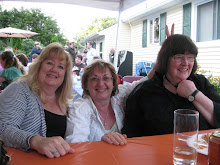I thought I would write a piece to summarize 2009 for the Communication Services Department of WAPADH. Each of us here at WAPADH work to empower all individuals to maximize the quality of their lives through membership, interdependence, and self-advocacy. The communication services department has had a busy year living up to just this. The department currently consists of Katie Bernal and two wonderful Independent Contractors, Cristina O’Reilly and Nancy Brady. In addition we support three Communication Partners who work in home and school based programs with two high school students. Our services continue to include assessments, therapy, consultations, supervision, and trainings.
The year has been very busy. In January Dr. Christi Kasa-Hendrickson, of University of Colorado and I were brought out by the Inclusion Connection in Iowa to train in our second Mentor Project. This training series happened on a monthly basis for four months with participants coming from Iowa and Illinois. The group continues to meet on a regular basis. 14 individuals, as well as their family members, and professionals developed new means of communicating.
In February I joined Christi to present and then train at the annual Peak Conference in Denver Colorado. Locally a group of 5 school age students who use AAC to actively participate in their education presented a short session for TACA in Orange County, CA. The students were nothing short of spectacular and will present again in July of 2010 at the West Coast FC Symposium.
In the spring an article in the Autism File (April 2009): Using Augmentative Communication with Individuals with Autism is more than just giving them a device was published. Then in May I partnered with Mei Mei Liu and Hunter Swersky to present at Chapman University in a strategy workshop for educators. We were able to share with new and seasoned professionals and families how efficient communication can impact an education.
This summer WAPADH sponsored their first Skill Building series in three separate locations. Participants signed up for six weeks of training. The trainings were held in Santa Fe Springs, Costa Mesa, and Los Angeles. We thank the Vinyard Church of Costa Mesa, and Vista Del Mar of Los Angeles, and Janne Peters for their additional support. The training was a big success and we look forward to providing more in the future. In July Brady and I were able to attend and participate in the FC Institute Summer Conference in Syracuse, New York. This year was very exciting with many new faces.
Come August training season began. Both Katie and I spent many hours supporting teams to prepare for the start of the new school year. We were able to train teams in San Jose, Tulare, and Baltimore. As well as teams in the Los Angeles, Inland Empire, San Diego, and Orange County areas of Southern California. School based trainings have continued throughout the school year as needed. In October we sponsored a one-day training for community members, with a follow up session for those who wanted additional support in getting started. WAPADH continues to partner with WACSEP and other groups to support and advocate for efficient communication for those who have difficulty using their speech.
In the fall we continued our momentum with our first meeting for the West Coast FC Symposium of 2010. The plans are coming together so watch for the SAVE THE DATE flyer coming soon. The Symposium will be July 22-24, 2010 in Whittier, CA..
In October WAPADH launched our new website and are working diligently to use the website to connect with people and share more information. Each of the three departments has lists of Frequently Asked Questions and a blog to keep the information flowing.
As 2009 comes to a close we are looking forward to 2010. There are so many exciting ideas in the hopper. We look forward to using technology to connect with more of you, and developing ways to connect more of you with each other. We promise to continue the trainings and then the monthly workshops. It is our commitment to empower all individuals to maximize the quality of their lives through membership, interdependence, and self-advocacy that keeps us going and excited about what we do, and more importantly what we see individuals, families, and professionals achieve.
We want to thank all of the wonderful parents and support persons, as well as school districts whom support and respect communication for all for their positive and productive team work.
We wish you all the best in 2010.
Darlene, Katie and all at WAPADH

